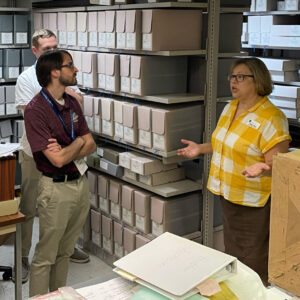by Matthew Turner (Educator, Warren County High School)
The Marshall Foundation has a treasure trove of resources I was first introduced to through their Summer Teachers Institute last year. My name is Matthew Turner, and I teach high school juniors in a Dual Enrolled U.S. History course and was blown away by how much I both enjoyed and benefited from my days at the Foundation. When given the chance to return this year, I immediately took it. These institutes also led me to an opportunity to directly participate in their project to digitize the vast Marshall Papers collection, for which I am both happy and grateful.
From Teacher to Digitization Partner
My role in the project, along with a group of other dedicated individuals, is to read through each document and assign them appropriate subject headings or metadata tags, so that when the documents are added into the library catalog they can be easily pulled up by searching for the relevant tag. Names, events, organizations, battles, equipment, and locations are just a few of the criteria that we are sorting through when reading and describing these documents. They can range from personal correspondences and birthday wishes to top-secret military operations, and discussions with foreign royalty about the Marshall Plan. Currently, I am going through a series of in-depth memoranda and declassified messages between Marshall and Admiral Ernest King concerning operations in the Pacific and Southwest Pacific against the Japanese.
I have personally gone through more than a thousand documents, with many more left. It is truly an amazing effort, since it will not only preserve these vital pieces of history, from World War I up through Marshall’s roles as Secretary of State and Defense, but also make them accessible for use by anyone. As a historian, this is a fantastic opportunity to take part in something meaningful and to share these valuable documents with others.
As a teacher, digitization efforts such as this are a dream come true. As mentioned, I work with college-bound dual-enrollment U.S. history students, and one of the most valued skills that we can build and reinforce in class is close-reading using relevant primary sources. The more primary sources we have available to work with, the better. For a lot of our units, there are limited primary sources available and easily accessible for students or for other educators. Having the digital Marshall Papers and their behind-the-scenes looks at so many different key periods of U.S. history is an absolute blessing, and this treasure of resources in the library catalog will soon be available to use.
Bringing Primary Sources Into the Classroom
I have already pulled out some of the documents to use with my students on World War II and the Cold War. I assign document-based essay questions as a primary means of assessing student understanding, and the ability to have these resources to create new document-based questions cannot be overstated. These documents, combined with the photographs and other resources already available on the Marshall Foundation website, have made up the bulk of my unit both in the DE class and also in my sophomore Modern World History course, as a way to get younger students to start thinking more critically about history.
Another way I plan to use these documents is as an open lesson for students to explore the library catalog on their own. This is a fantastic way to let students learn and take a more direct approach with a lesson, encouraging them choose a topic and then find evidence to support an argument or specific details about an event. The freedom to find their own documents and information can interest students who otherwise might not engage with a topic, or focus on one specific part of the unit that fascinates them.

